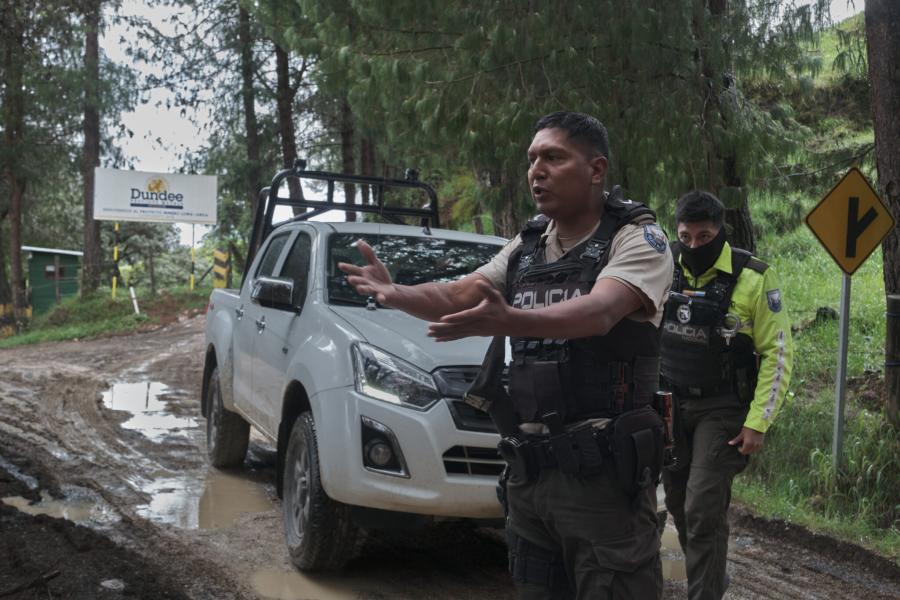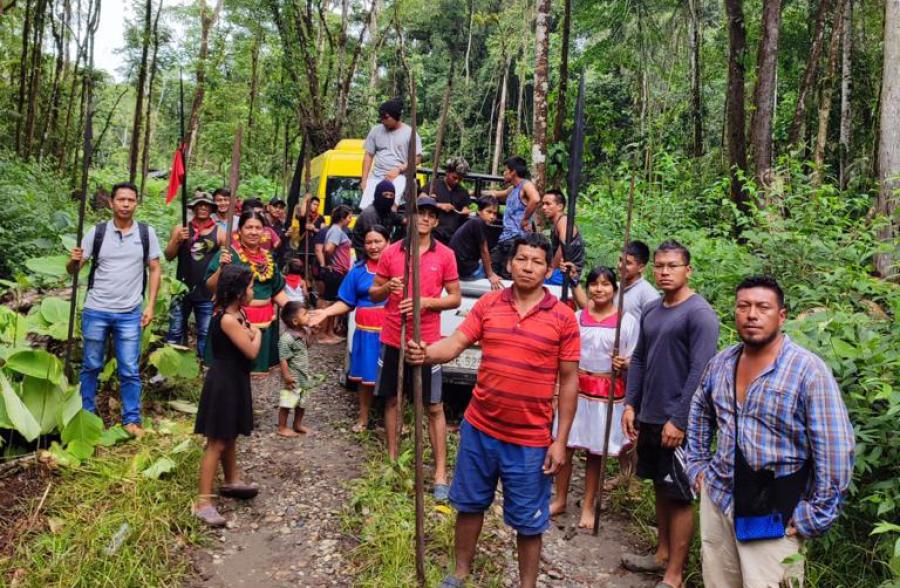The recovery and protection of sacred sites is at the heart of cultural survival among Indigenous populations in the Andes. That effort comes into sharp relief when those sites are directly threatened. Such was the case in July, 2010, in northern Ecuador’s Imbabura province, when plans to broaden the Pan-American Highway to six lanes endangered a sacred spring known as San Juan Pukyu in the community of Ilumán Bajo. One hundred and eighty Indigenous families from the community mobilized to oppose the road expansion and were met by 350 police in riot gear sent from the provincial capital, Ibarra. In this article, Taita José Rafael Carrascal Cacuango, spiritual leader in his community of ethnic Otavalans, president of the Association of Yachaks of Ilumán, and president of the Union of Communities and Neighborhoods of the Parish of San Juan de Ilumán, talks about the importance of ritual sites in Ecuador and the role that shamans (known as yachaks or “ones who know”) play in carrying forward ritual traditions and cultural knowledge.
The yachak is the one who guides the community as a spiritual leader. In the past, the role the yachaks played was quite strong, quite important, but we have lost some of this. When the Spanish arrived, the yachaks started disappearing and being afraid. They were cast aside even up until a few years ago. But lately attitudes have been changing, supporting a perspective that our reality does exist, that it is a reality that belongs to us as part of our tradition, our roots; a reality that cannot be denied. And people are beginning to accept it even though it is a way of life they have always had. So although for now we are not playing a terribly important role, we have to keep working to recover our place.
For instance, we have worked to get the Association of Yachaks of Ilumán recognized, and it was legalized in 1999. There are around 44 to 47 yachaks in the association. [This is an association of shamans specific to the town of Ilumán. There are other shaman associations throughout the Otavalo region.] Here, there are different kinds of yachaks. I am a yachak by heredity. Other colleagues are yachaks because they have godparents from the Oriente [Amazonian Ecuador]. Others are simply born with this gift. So there is a bit of a difference between those who inherit the gift, those who are born with it, and those who have godparents in the Oriente.
Day by day the yachak develops through what he himself lives, through waking up every day and seeing new things, new patients, new illnesses. This is how the yachak acquires more experience, more knowledge. I think that what one feels or what one sees, what one touches is what we should believe. So, for instance, when we make a person bathe in the sacred spring of San Juan Pukyu, they feel the cold; they feel the reality. And when we do a cleansing, one feels what one is.
The yachaks’ code is about healthy intervention. Mediating health is what we completely commit to. Our job is to do good and to guide, because the yachak does not just heal. There are many, many people who come to us who are not in need of plants, nor do they need to have their energy healed. Instead, they need advice. This is why fellow yachaks from Otavalo often say that we have to cure people from thin air. This is because a yachak automatically knows what the person needs, like a psychologist, more or less. So we are also spiritual guides; guides who make people see things more clearly. Everything we do is for the people, for our own lives, for nature itself.
Most of the rituals we perform are during the season of the summer solstice. The sun for Indigenous people is very important, especially for the shamans. We say that the sun is power, energy. The ritual of the tinkuy relates to the sun, which, with its energy, can destroy. This is why the tinkuy is also the ritual of war. At the same time the sun gives life. Contact with the moon, what we call the quillamama, can destroy, and, at the same time, it can give fruit. This is why we believe in the sun and the moon and the earth mother. For us “tinkuy” in Quichua means change, power, rebirth. During the summer solstice, we perform this ritual so that the bad can be destroyed and so that the good will allow the earth mother to give fruit. This is what we always do.
To elect the president of the community, we have always had to do the ritual of war, the tinkuy or “change of command,” as we refer to it. In life, what will happen as a leader? The first thing is a war. This can be an ideological war, a battle about what one is going to work on. Like any position of command, it implies a sacrifice of some sort—a sacrifice so that the person changes as he destroys the bad, the negative, and at the same time allows a new person, a new ideology to be born. This is why we perform the tinkuy—so that one becomes good, for a good harvest, good fruit, good people, to become more intelligent. In that way we can become a pueblo [a united people].
The ritual of war or tinkuy can indeed be like a fight, depending on what the society is going through [in other communities in the region the tinkuy is performed as an actual battle among dancers], but we do it more in the ritual sense. Here we always dance, turning in circles, backwards, forward. “First is the right hand, carajo.” Then “turn, carajo!” The dancers shout like that, with the other hand. The vuelta [turn] is for someone to express that they want change—change for their family, to have more life, to be more at peace in the future, to become better. Turning is part of the ritual itself.
During the summer solstice we do the ritual of the dove for healing ceremonies when the sun is directly overhead. This is another ritual for change. Then there are rituals to expand our knowledge, or rituals so that there will be better governments in this country. These, too, correspond to the rituals of war. When we did this ritual, all of Ecuador was amazed. [Yachaks performed these rituals during the administrations of presidents Bucaram and Mahuad (1996-2000), who ultimately were ousted by popular movements].
San Juan Pukyu and also Rezas Pukyu up in the mountain are especially significant for the ritual of the tinkuy. San Juan Pukyu, in the town of Ilumán, is a sacred spring where the community celebrates everything—all of the fiestas [ritual celebrations] like marriage ceremonies, the Inti Raymi [festival of the sun], the ritual of war, the Ñawi Maillay [ritual washing of the face with water and flowers] which is the sacred marriage ritual, everything. Besides that, the water of this spring is medicinal. Many people have come to be healed here. For us this is a sacred site, a delicate site. What we have come to know is that in the past, yachaks from other provinces and countries, including well-known yachaks from Colombia and Venezuela, would come to do the bath of purification in Rezas Pukyu and San Juan Pukyu. It is as if their energy stayed there. This is why these sites have more energy, more power. And because there are yachaks here in the area of Ilumán, this is why there is even more strength, more energy.
Most of all for the women, San Juan Pukyu is important. When they wash clothes there, it is as if the clothes turn out more beautiful. Just by wearing the clothes they automatically feel something pretty, something clean. This is why, although they now have piped water in the town itself, some of the women still prefer to go to San Juan Pukyu and Rezas Pukyu. They bathe there. They wash clothes there.
It is as if there were an eye that sees all of the mountains from Rezas Pukyu—first, Mount Imbabura, and then it goes to Mama Cotacachi, then Mojanda, San Pablo, Cuicocha. [At 15,000 feet, Mount Imbabura towers over the community of Ilumán on the east side of the Otavalo valley; Volcano Cotacachi stands 16,000 feet tall on the west side of the valley. Mojanda, San Pablo, and Cuicocha are lakes that are paired with their respective mountains in the anthropomorphized geography of Imbabura province]. It is as if Rezas Pukyu were the axis, because there is a lot of power there. Some people have said that the Lechero [a tree on Reyloma] is the center. But we believe it is over there in Rezas Pukyu. This is what draws us to this site. And these activities we have been doing are to reveal this truth little by little.
There is a fuerza (energy, strength), one would say, among the people from Ilumán Bajo. The people from the community, because of the simple fact of having San Juan Pukyu, turn out in greater numbers for ritual celebrations and community events, and they draw their strength from the spring. The energy of the spring gives people the courage to discuss how to do something to have a voice and have decision-making power.
When the police came in July, we were clear with the gentlemen from Ibarra that we would continue to obstruct the highway project until they did a clear study to indicate that San Juan Pukyu would not be affected. Our most urgent message is that as Indigenous communities we strive for unity through the mingas [community work parties] and the ritual celebrations. It is important that at an international level people know that this is something that we value; something that we need to rescue for the future so that it is not lost for our children and our grandchildren.
This article is based on interviews with José Rafael Carrascal Cacuango that anthropologist Michelle Wibbelsman conducted and translated in 2001 and 2010. Wibbelsman, a research fellow at the Lozano Long Institute of Latin American Studies at the University of Texas at Austin, has worked among Otavalan communities since 1995 and is the author of Ritual Encounters: Otavalan Modern and Mythic Community (University of Illinois Press, 2009).


